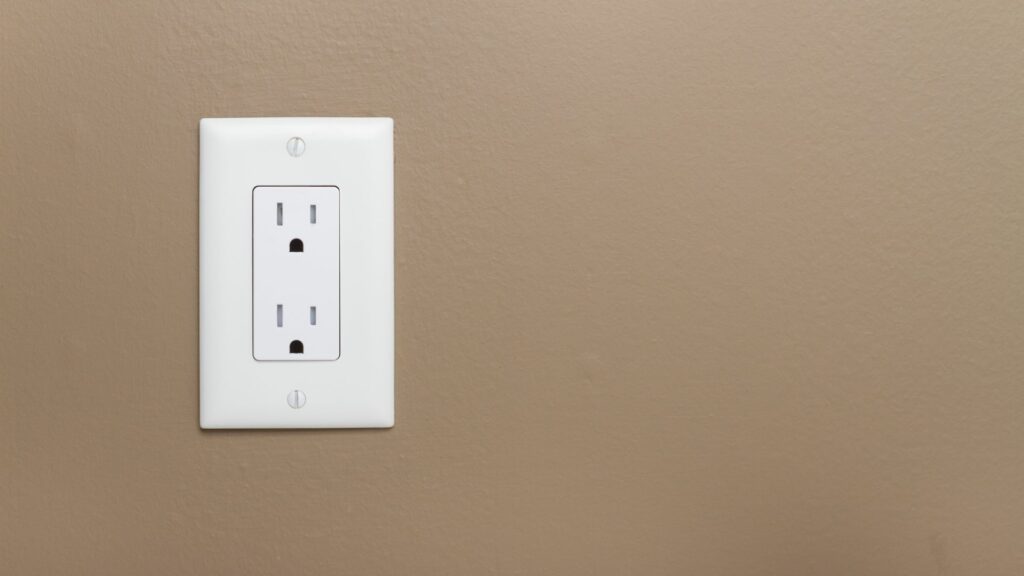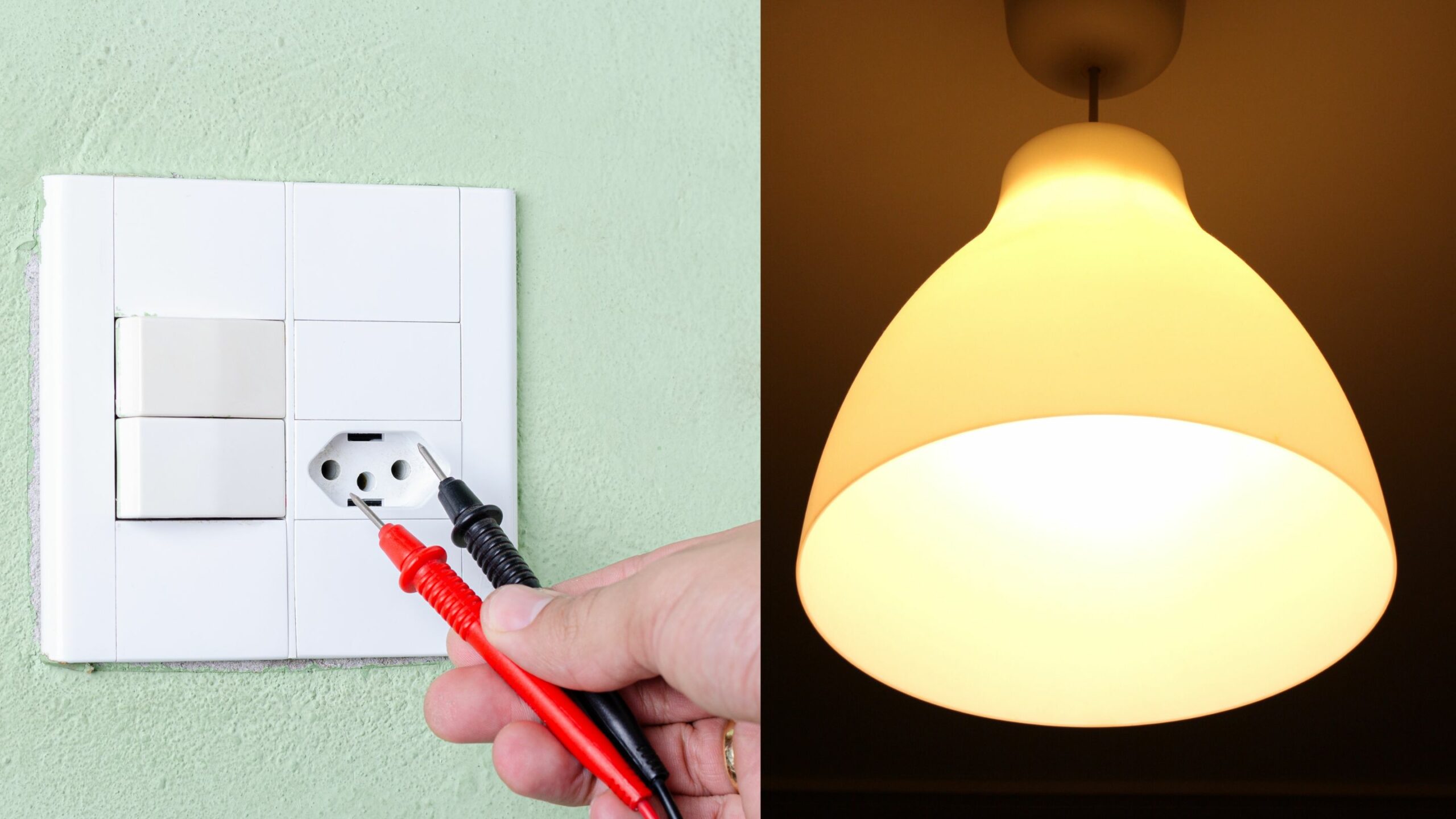Many people place the lights and outlets on the same circuit. Therefore, if the lights are on, you’re not wrong in wondering why the outlets have refused to work.
Lights Working But Not Outlets – Why?
1). Half-Hot Outlets
Many people blame this issue on half-hot outlets, even though they are rarely at fault. Most homeowners know what half-hot outlets look like. They won’t confuse them for ordinary outlets. Although, that is not true for everyone.
A half-hot outlet has a top section that is always hot and a lower area that a nearby switch controls. Do you have a light switch in the room that doesn’t do anything? That switch probably turns the lower section of the outlet on and off.
You can test your theory by connecting an appliance to the lower section and flipping the switch to the on position. People that don’t recognize half-hot outlets may assume that the lower area has stopped working. But again, most owners recognize half-hot outlets.
2). Faulty Appliance

Are you sure the outlet is at fault? Sometimes, the connected appliance is the problem. It has developed a fault, or the plug is dead. Either way, don’t tamper with the outlet until you connect a second device. If the second device starts working, the first appliance is the problem. The outlet is fine.
3). Faulty Outlet

Outlets fail all the time, which is why electricians replace so many of them each year. An average outlet lasts 25 years. But some homeowners replace their outlets every few months for a variety of reasons, including:
- Factory Defect – Some outlets have factory defects that lower their lifespan. They will stop working the moment you install them, or they will last a few days or weeks before failing. Some consumers are unlucky enough to buy multiple outlets from a defective batch.
- Burn Out – Outlets will burn out if you expose them to significant surges and overloads. Breakers are supposed to prevent such outcomes, but they don’t always respond quickly enough to protect your equipment. Look for burn marks inside and outside the outlet.
- Damage – You can damage outlets by mishandling them. For instance, if you repeatedly strike them with hard objects or harm the contacts by ramming sharp objects through the slots.
- Age – Outlets have a limited lifespan. If you’ve had yours for several years, don’t be surprised if they stop working.
It is worth noting that faults cannot strike all your outlets simultaneously. You may lose one or two at a time. But if every outlet in the room is dead, and the lights are working, something else has gone wrong.
4). Tripped GFCI
You will see GFCI protection on the outlets in the bathroom and kitchen. But GFCIs are tricky because it is too expensive to install this technology on every outlet, which is why contractors prefer to daisy-chain the receptacles such that one GFCI outlet protects multiple traditional outlets down the line.
But if that GFCI outlet trips, all the other receptacles down the line will stop working. How many GFCIs do you see? Have the reset buttons popped out? This signifies a tripped GFCI. Fortunately, this issue has an easy answer.
A GFCI breaker will produce similar results. However, it will deprive the entire circuit of power, including the lights. You cannot blame the GFCI breaker for a situation where the lights are on, but the outlets won’t work.
5). Outlets Are On Separate Circuit
Are you sure the lights and outlets are on the same circuit? Many people prefer to place them on the same circuit. But it is just as common to give the lighting a dedicated circuit. If the lights and outlets exist on separate circuits, a tripped breaker will deprive all the outlets of power.
Older homes use fuses. In that case, an overload will blow the fuse, depriving all the outlets of power. Circuit breakers are more reliable than fuses. But a fuse is better than nothing.
6). Loose Wiring
If one or two receptacles have refused to work, check the wiring. Loose connections can interfere with the outlet’s operations. But loose wiring is not a convincing explanation for multiple failures. The chances of every outlet in your home developing loose wiring simultaneously are slim.
What Should I Do To Fix The Outlet That Is Not Working?
You have several practical solutions to dead outlets at your disposal, including:
- Replace faulty outlets. You can repair some outlets. But if they have black marks and apparent signs of damage, get replacements. It is the safer option. You should also take a moment to find out what happened. If the outlets fell prey to an overload, what caused the overload? If you don’t find the cause, future outlets will suffer a similar fate.
- Connect a second appliance to the dead outlet. If the second appliance works, the outlet is OK. The first appliance has a fault. Take it to a technician for troubleshooting.
- Check the breaker. Reset the breaker if it tripped. Like the outlets, find out why the breaker tripped. Get the total wattage of your devices and compare it to the circuit size. Is the circuit too small? Is the breaker defective? Did a surge from the grid fry the breaker? Find the problem before it trips the breaker again. Common signs of bad or overloaded breakers include flickering lights, crackling sounds, and warm outlets.
- Reset a tripped GFCI. If the outlets are still dead, troubleshoot the GFCI. Look for loose wiring, moisture, debris, factory defects, etc. Replace faulty GFCIs. They are only slightly more expensive than conventional receptacles.
- Tighten loose wires. Replace the cables if they are torn and damaged beyond repair.
Can I Fix The Outlet Myself?
It depends on where you live. According to the City of Atlanta (office of Buildings), you need an electrical permit to install or alter permanent electrical devices. However, that doesn’t include the replacement of electrical outlets and light fixtures, and switches.
But if your city or state demands an electrical permit to install or replace an outlet, they may prevent you from performing this task because you’re not a licensed electrician. The rules are even more stringent for people that want to replace circuit breakers and permanent wiring.
Consult a local electrician before you proceed. They will tell you whether or not you can fix your outlets, breakers, and fuses without professional assistance.
How Much Electricians Charge To Fix The Faulty Outlet?
Replacing a standard outlet seems cheap. After all, new outlets are $5 or less. But what if you need a dozen or more outlets? Your expenses will skyrocket, especially if some of those receptacles are GFCIs.
Don’t forget the labor costs. Forbes expects consumers to spend as much as $175 on a standard outlet. But what if they troubleshoot your circuit and determine that a tripped GFCI is the problem?
You fix tripped GFCIs by pressing the reset button. However, the electrician may still charge you $100 or more for their troubles. This is why homeowners prefer to resolve this issue without assistance. It is the cheaper option.
Related post:

